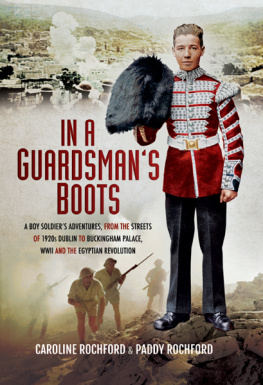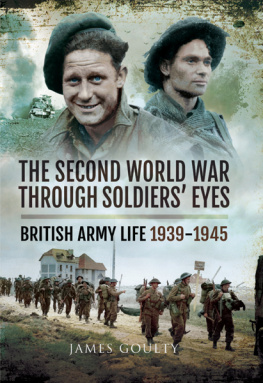BOOTS
ON THE GROUND
GENERAL THE LORD DANNATT GCB CBE MC DL served in the army from 19692009, during which time he led troops in Northern Ireland, Bosnia and Kosovo and held the positions of Commander-in-Chief, Land Command and Chief of the General Staff. On retiring from the Army, he was Constable of the Tower of London from 2009 to 2016. His autobiography is Leading from the Front (Corgi, 2010).
ALSO BY GENERAL THE LORD DANNATT
Leading from the Front: An Autobiography
BOOTS
ON THE GROUND
BRITAIN AND HER ARMY
SINCE 1945
RICHARD DANNATT

First published in Great Britain in 2016 by
PROFILE BOOKS LTD
3 Holford Yard
Bevin Way
London WC1X 9HD
www.profilebooks.com
Copyright Richard Dannatt and Sarah Ingham, 2016
The moral right of the author has been asserted.
All rights reserved. Without limiting the rights under copyright reserved above, no part of this publication may be reproduced, stored or introduced into a retrieval system, or transmitted, in any form or by any means (electronic, mechanical, photocopying, recording or otherwise), without the prior written permission of both the copyright owner and the publisher of this book.
A CIP catalogue record for this book is available from the British Library.
eISBN: 978 1 78283 123 5
ACKNOWLEDGEMENTS

H aving written my autobiography Leading from the Front, which was published by Transworld in September 2010, I presumed that would be the sum total of books written by myself. I was therefore a little surprised when Charlie Viney, who had been my agent for the original book, introduced me to Andrew Franklin of Profile Books, who asked whether I would consider writing a history of the British Army since the Second World War. After some considerable thought, I gave Andrew a positive, but qualified, answer the qualification being that I wished to broaden the canvas. The book that I wished to write would be more of a commentary on Britain as a country since the Second World War, albeit seen through the perspective of the Army and allowing the account of what the Army has done since 1945 to be the handrail through the commentary. Andrew agreed to this changed prospectus and the title: Boots on the Ground Britain and Her Army since 1945 was agreed.
A near neighbour of mine in Norfolk is the much respected historian, Correlli Barnett. As the author of the original Britain and Her Army published by Allen Lane in 1970, I have been most grateful to Bill as his friends know him for his enthusiastic support for my project from the outset. He very kindly and most helpfully commented on the final draft. Although Bills book covered nearly four centuries, from Henry VIII to 1970, and mine would only have about a seventy-year span from 1945 to 2016, I knew that finding the right researcher to work with me was going to be critical. I found that person in Dr Sarah Ingham whose contribution to this book has been immense. I first met Sarah when she was doing her own research for her PhD on the Military Covenant at the War Studies Department, Kings College London. She duly completed her Doctorate and her thesis was published in 2014 by Ashgate under the title: The Military Covenant: Its Impact on CivilMilitary Relations in Britain. She kindly sent me a copy which convinced me that I had found the right person to help me with Boots on the Ground. She has worked tirelessly on this project, researching in great detail in order to expand my original synopsis and then doing much of the initial drafting. Frankly, there would have been no book without her. That said, I take full responsibility for this book. Any errors or important omissions are mine, and any copyright inadvertently infringed is also my responsibility. Corrections will, of course, be made in any subsequent editions.
I would also like to record my enormous thanks to those who have also helped with the production of this book. In particular I would like to thank my Green Howard Regimental colleague and close friend, Brigadier John Powell, who read the final draft and made a series of detailed and wise observations. John made one comment which I had to consider most carefully. He thought that as someone who had served in the Army for forty of the seventy years covered by this book that my style was somewhat detached, given especially that I had been Chief of the General Staff at a critical time of operational pressure for the Army from 2006 to 2009. To answer that criticism, which others may share, I would point back to my 2010 autobiography. It is in that volume that you will find my personal opinions, hence my ambition for more objectivity in this volume. I reserve some final conclusions for the Epilogue.
I am also very grateful to two exceptionally busy people who have been kind enough with their time to review the text of this book General Sir Nicholas Carter, the present Chief of the General Staff, and Lord Hennessey, eminent historian, broadcaster and colleague in the House of Lords. I would also like to record my thanks to General Sir Hugh Beach who provided invaluable advice at the start of this project. I also wish to thank the Trustees of the Imperial War Museum for their kind permission to use materials from their collection and, in particular, to acknowledge the help of the Documents and Sound Section. My thanks also go to the Trustees of the Liddell Hart Centre for Military Archives at Kings College London and to the Director and staff of the National Army Museum.
At Profile Books, in addition to Andrew Franklin, who has personally led the editorial team, I am most grateful to Penny Daniel for her patient help with the text and the illustrations and to Sally Holloway who did the detailed copy editing. Valentina Zanca is leading the publicity and marketing for this book with great energy, for which I thank her, too. My thanks also go to Louisa Dunnigan for her work on the book cover.
As ever, any project has significant domestic impact and I am much indebted to Philippa, my wife, for giving me the space to work on this book. The final stage coincided with my retirement as Constable of the Tower of London and our move from Queens House in the Tower to our home in Norfolk. Once again, Pippa has carried the burden of this, seamlessly integrating the contents of two houses into one home, ably assisted by Colour Sergeant (retired) Steve Crighton MBE who has now worked for me for twenty-seven years. Gilly Goldsmid, my PA in the House of Lords, has managed my diary with great skill to generate enough time for this project.
My final comment, made in the Epilogue at the end of this book, is to draw attention to the Elizabeth Cross, the emblem presented to the next of kin of all those servicemen and women who have lost their lives on operations since just after the end of the Second World War. Their sacrifice and service to our country underpins this story of Boots on the Ground Britain and Her Army since 1945. In all humility, I dedicate this book to their memory and to their families, who had to come to terms with each and every loss of a loved one for our country our England, Wales, Scotland and Northern Ireland.
INTRODUCTION

T he Union flag, the khaki tents and camouflage nets were swept by chill gusts of wind and rain as Field Marshal Sir Bernard Montgomery received the delegation from the German High Command in the early evening of 4 May 1945 at his headquarters at Timeloberg on Lneburg Heath. The five men, led by Admiral Hans Georg von Friedeburg, Commander-in-Chief of the Navy, had come to surrender all German armed forces in north-west Germany, Holland and Denmark. Montgomery, the Commander-in-Chief of the 21st Army Group, ensured they waited for him beneath the Union flag before they were taken to a tent adjacent to his command caravan. They were seated at a trestle table covered by a grey British Army blanket and required to listen to the terms of the surrender, read out to them by him. At 6.30 p.m., using an ordinary Army pen that cost tuppence, the German commanders signed the surrender document beside the single British signature of BL Montgomery, Field Marshal. On 7 May, at Allied headquarters in Reims, Germany agreed to an unconditional surrender which would come into effect the following day, celebrated as Victory in Europe (VE) Day. The war in Europe was over. For the British Army, this was its greatest achievement since Wellingtons victory at Waterloo.
Next page














